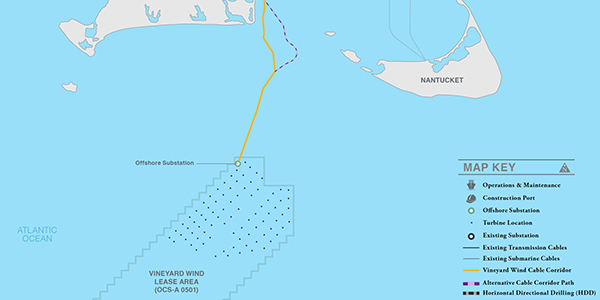Offshore wind advocates said Wednesday they were encouraged by the U.S. Bureau of Ocean Energy Management’s release of its supplemental environmental impact study (SEIS) on the 800-MW Vineyard Wind project, raising hopes that developers could begin construction as soon as next year.

| Vinyard Wind
BOEM had issued its draft EIS in December 2018, leading to expectations that the agency would issue a record of decision approving the project in 2019. But last August, BOEM said it would not issue the final EIS until it completed a supplemental report looking at the cumulative impacts of Vineyard Wind and other offshore wind proposals in development.
The new report, issued June 9, considers 22 GW of Atlantic Ocean OSW projects from New England to Virginia.
The report found that the cumulative effect of the projects could have major impacts on navigation and vessel traffic, commercial fisheries and military and national security uses.
The report reflects changes to the project since the draft EIS — replacing 10-MW turbines, 696-feet tall with 14-MW turbines, 837-feet tall.
It also includes a new alternative proposed by the Responsible Offshore Development Association (RODA), a fishing industry group, calling for “transit lanes” at least 4-nautical-miles wide. The proposed transit corridor proposed for the Vineyard project would provide a path for vessels traveling from New Bedford, Mass., and other southern New England ports to fishing grounds on Georges Bank.

Alternative F—Vessel Transit Lane Alternative | BOEM
A Vineyard spokesman said the developers were still reviewing the 420-page report. “We’re pleased that BOEM has published the draft SEIS and look forward to engaging with the agency and the many different stakeholders as we continue to make our way through this important public process,” he said.
“BOEM has taken the first in a series of important steps in finally unlocking the enormous potential for offshore wind,” said Tom Kiernan, CEO of the American Wind Energy Association. “The offshore wind industry is committed to working closely with other ocean users and remains confident that the deployment of offshore wind is compatible with commercial fishing and safe navigation, as has been demonstrated for years in other countries.”
Liz Burdock, CEO of the Business Network for Offshore Wind, praised BOEM for “staying on time and on target” in issuing its report.
“The final approval of [the] supplemental EIS this fall will have a domino effect leading to the construction of 9,000 MW by the end of 2030. It will also kickstart a decade that will see the creation of a multi-trillion U.S. blue economy employing thousands,” she said.
ClearView Energy Partners was bullish on the project’s chances of approval. “While President Donald Trump has occasionally criticized offshore wind, we think approving the project would align with the president’s `energy dominance’ agenda,” the firm wrote in a note to clients. Trump issued an executive order in 2017 promoting the development of domestic energy resources, including renewable energy.

Scope for Future Possible Development of Offshore Wind | BOEM
ClearView also said the report “could reduce judicial review risk for other offshore wind projects, particularly if those projects are able to incorporate vessel transit corridors and share a regional transmission system or cable corridor.”
BOEM noted that it has received comments requesting that it mandate the use of a regional transmission cable system for the project but said it was “unfeasible primarily because such a system does not yet exist, and BOEM has issued no right-of-way (ROW) for such a system.”
Anbaric Development Partners has submitted proposals to BOEM to develop two open access offshore transmission systems, one for New York and New Jersey and one for Southern New England that could connect to Vineyard.
BOEM said there is no proposed timeline for the projects nor a plan for who would pay for transmission capacity exceeding Vineyard’s needs. “The proposed project timeline would be substantially delayed by the time needed to properly plan a regional transmission network that would not reduce system resiliency or pose capacity issues for onshore substations,” BOEM said.
“The routes for these proposed regional cables have not been determined at this time and are not considered reasonably foreseeable, but BOEM assumes that if future offshore wind projects utilize one of these open-access transmission systems, the impacts associated with new cable emplacement and maintenance activities would be less than if each individual project installed its own cable,” it said.
The agency will accept comments for 45 days after the SEIS is published in the Federal Register, keeping BOEM on schedule for publishing a final EIS in November and issuing a final decision by December. That would allow Vineyard Wind to begin construction in 2021 and begin service in 2022.



